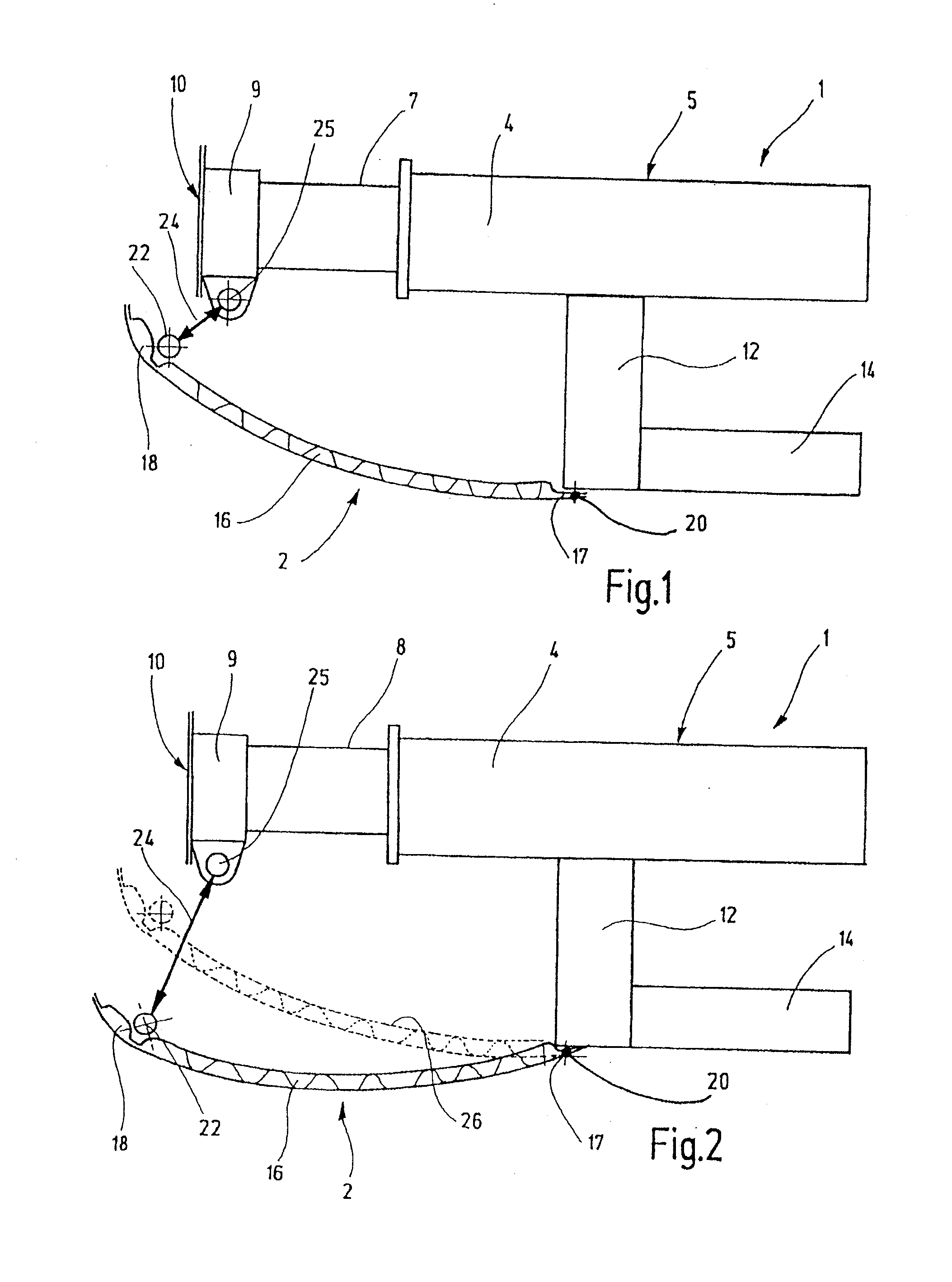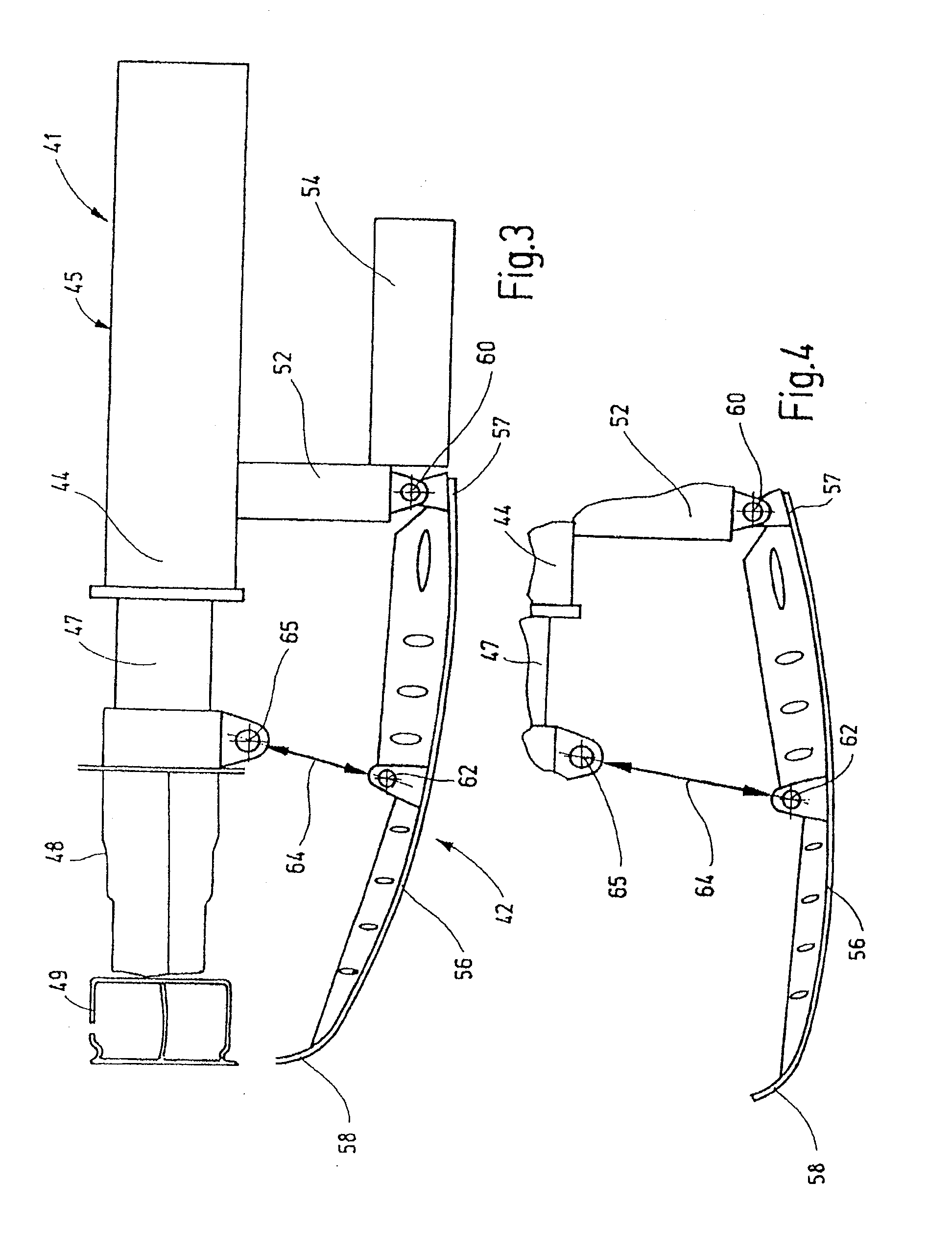[0019]In a further preferred exemplary embodiment of the motor vehicle, the impact plate has high intrinsic rigidity in the longitudinal direction of the motor vehicle. The intrinsic rigidity of the impact plate, which is essentially of sheetlike, i.e. plate-like, design, is preferably achieved by the thickness of its wall or by corresponding embossings on the impact plate, preferably in the longitudinal direction of the motor vehicle. The embossed impact plate can also be configured, by means of a closing plate, to be in the form of two shells, thus producing support elements. The impact plate can also open on its front side into a support part, which provides a load-distributing effect when a pivotable structural module is activated.
[0012]In a further preferred exemplary embodiment of the motor vehicle, the impact plate is coupled to a front axle member of the motor vehicle. Large longitudinal forces directed in the longitudinal direction of the vehicle can be introduced by the impact plate into the supporting structure of the motor vehicle via the front axle member.
[0013]In a further preferred exemplary embodiment of the motor vehicle, the impact plate extends into a bumper region, in particular a front bumper region, of the motor vehicle. In the extended position of the impact plate, the outer, front end of the impact plate is preferably arranged between the front or rear bumper region of the motor vehicle and the ground. As a result, the ground clearance of the motor vehicle can be reduced in this region.
[0009]To achieve the object, a motor vehicle having an underprotection device with an impact plate fitted to the underside of the motor vehicle and movable between a retracted and an extended position is proposed. The impact plate can be arranged at the front, the rear, or laterally on the underside of the motor vehicle. A plurality of impact plates may also be arranged at different locations. In its retracted position, the impact plate permits a large ground clearance and a high overhang angle. In its extended position, the impact plate prevents the underriding of a collision partner with a low front structure by using an impact surface or impact edge arranged at a lower level, preferably level with its
crash structure, to provide resistance to the collision vehicle. In its extended position, the underprotection device therefore takes on the function of an underride protection device.
[0018]In a further preferred exemplary embodiment of the motor vehicle, the impact plate is deformable in a defined manner in the longitudinal direction of the motor vehicle. The effect achieved by an intended, defined deformation of the impact plate is that, upon a collision with a collision partner, impact forces can be absorbed.
[0021]According to a further preferred exemplary embodiment of the motor vehicle, the outer, front deformation section is of interchangeable design. This simplifies the repair of the underprotection device. In addition, costs are saved, since, after an accident at low speeds, only a part of the impact plate has to be interchanged rather than the entire impact plate.
[0022]In a further preferred exemplary embodiment of the motor vehicle, the impact plate comprises an outer, front deformation section, which is fitted to an inner, rear supporting section that has higher rigidity than the outer deformation section. The aim of the different levels of rigidity is to realize, for collisions at lower speeds, a deformation characteristic which avoids damaging an integral member of the vehicle supporting structure, which integral member is located behind the underprotection. The front region in front of the region in which the
actuator assembly is connected can therefore be configured such that it is of interchangeable design.
[0026]In a still further preferred exemplary embodiment of the motor vehicle, the impact plate is arranged in its retracted position during normal operation of the motor vehicle and is moved into the extended position only when the need arises. The movement of the impact plate is preferably controlled via a corresponding Pre-
Crash activation or Pre-Safe activation. The lowering and a locking in the extended position, which is also referred to as the compatibility position, are only initiated in the Pre-Safe situation or in the Pre-
Crash situation.
 Login to View More
Login to View More  Login to View More
Login to View More 


